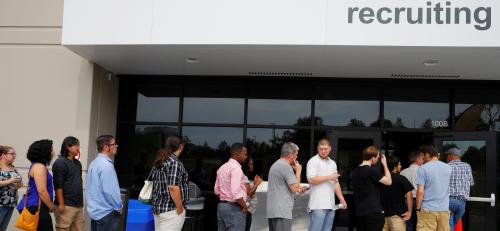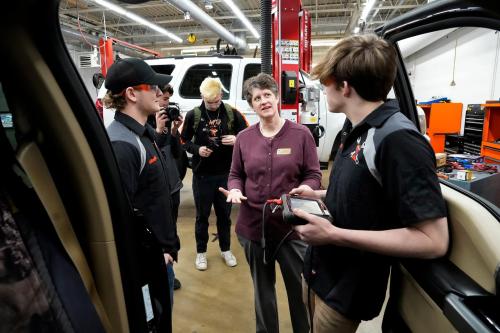Education beyond high school is critical to advancing beyond low-wage jobs, as reams of data and experience have shown. Those with only a high school diploma have higher unemployment rates and lower earnings than their counterparts with more education.
However, while the message about the importance of a college education is clear, the path is not always smooth. More education means more transitions—enrolling in a college or training program that’s affordable and a good fit, completing the program to earn a degree or credential, and then starting a career. Transitions are a time of promise but also vulnerability.
In this blog post, we look at 18-24 year-olds who are not enrolled in school to get a rough measure of how well young people are navigating these transitions. Almost half (48 percent) of all young people, about 15 million, are not in school. Some of them have graduated from high school or college, but many appear to have decided they were finished, to borrow Kanye West’s phrasing.
Most disconnected youth—those neither working nor in school—have a high school diploma
About 15 percent of all young people, or 4.7 million, fall into the category of disconnected or opportunity youth, meaning they aren’t in school and don’t have a job. Half of this not-working/not-in-school group has a high school diploma, and nearly 20 percent has taken some college courses but did not earn a degree. About 25 percent did not finish high school. Young people disconnected from school and work have received a great deal of policy and program interest as of late, and deservedly so: they face a number of roadblocks on the path to adulthood and successful careers.
One in three young adults go to work rather than school, but few have college degrees
However, larger numbers of the not-in-school group are working: 33 percent of all young adults, or about 10 million. Although these young people are connected to the labor market, not all connections are equal.
Career advancement prospects are limited for workers with low levels of education, and the data are not promising on this front: only one in five of the working/not-in-school group has an Associate’s or Bachelor’s degree. The largest share of the working/not-in-school group (nearly half, or 42 percent) has only a high school diploma; another ten percent has less than a high school education. That is, 5.3 million 18-24 year-olds—17 percent of all young adults—are done with school, at least for now, and are participating in the work world armed with no more than a high school diploma.

Vulnerable young people live in a diverse set of places
Disconnected young people are concentrated in places with above average unemployment rates. Many such places are contending with deindustrialization, the after effects of the housing bust and depressed consumer spending, general economic shifts favoring technology and digital skills, or some combination of these trends. They include cities with an industrial past, such as Detroit, Philadelphia, and Baltimore; less densely developed areas with an agricultural heritage, such as Hildalgo County in southern Texas and Kern and Stanislaus counties in California’s Central Valley; and Sunbelt areas with fast-growing construction, hospitality, or logistic sectors, such as Phoenix, Las Vegas, and several Florida counties. Many of these places have sizable black and Latino populations, who have lower rates of school enrollment overall.
On the other hand, almost half of the 20 places with the highest shares of employed young people with a high school diploma or less have tighter labor markets and lower unemployment rates. These include Tulsa County, Oklahoma; Salt Lake County, Utah; and a number of Texas counties in the Dallas, Houston, and San Antonio regions. With economies fueled by the energy sector, wholesale trade, advanced manufacturing, and professional services, these areas draw more people into the workforce, even those with less experience and education who might not otherwise be competitive candidates. The remaining places with high shares of working, high school-educated young people overlap with the areas with high shares of disconnected youth or live in places with similar economic characteristics in that their industry base does not require a highly-educated labor pool or they have an above-average unemployment rate.
Young people who have gotten a foothold in the labor market may not see as much need to pursue higher education, especially if they are not in an area with high demand for workers with Bachelor’s degrees, such as San Francisco or Washington, D.C. But this dynamic holds back not only their individual progress in the labor market but that of wider regional economies; well-paying jobs requiring higher levels of education are unlikely to locate and grow in places absent people with the skills to fill them.


We need better educational and skill-building options
Nearly 30 percent of young adults have left school but have no more than a high school diploma. Whether or not these young people are currently working (and most are), they are all but guaranteed a future of low-wage work unless they go back to school or otherwise increase their skills. Notably, more education is not confined to Bachelor’s or Associate degrees. Shorter-term post-secondary certificates increase employment and earnings and can act as stepping stones to degrees.
If choices after high school are low-wage work or a post-secondary landscape that is confusing, difficult to navigate, and financially out-of-reach, we are setting young people up for failure. There is much we can do to ease the transition from high school to post-secondary education and ultimately into the labor market:
- Offer much stronger advising to high school students about educational and career options;
- Provide high school students with an opportunity to get a head start on earning college credits through dual enrollment programs;
- Redesign high schools so they better prepare students for both post-secondary education and careers;
- Create stronger pathways into the labor market through such initiatives as work-based learning in high school, sector strategies tailored to young adults, and apprenticeships; and
- Make reforms within community colleges to increase graduation rates.
All of these options are within reach. They are intensely local in nature, although that does not negate the importance of state and federal policy in supporting or catalyzing activity. But ultimately, it is the leaders of school districts, high schools, community colleges, workforce investment boards, and training/youth development organizations who will design and implement new approaches—ideally in close coordination with area employers. In forthcoming research, we will provide new analysis of young adults who are out of work and suggest program and policy solutions in hopes of sparking greater discussion and action.








Commentary
Millions of young adults have entered the workforce with no more than a high school diploma
January 31, 2018